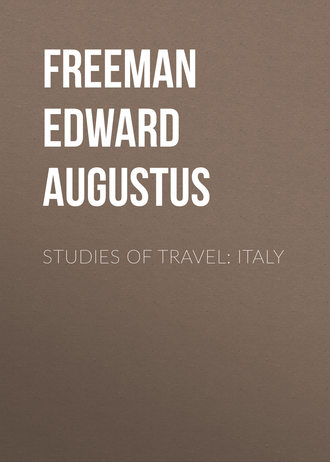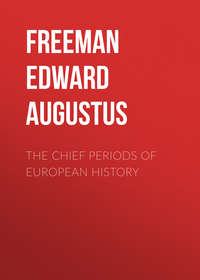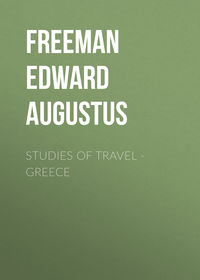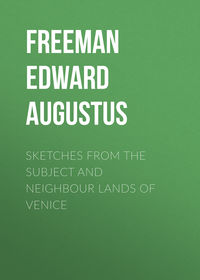 полная версия
полная версияStudies of Travel: Italy
As we draw near from Assisi, the Julian colony of Hispellum, the Flavia Constans of a later day, is becomingly entered by a Roman gateway which bears the name of Porta Consolare. But on the road from Foligno the consular gate is reached only through a mediæval one, which bears, as we have said, all the names of the town prominently set forth for the stranger's benefit. The consular gate stands at the bottom of the hill: for Spello thoroughly occupies the whole of its hill; there is plenty of climbing to be done in its streets; but it has all to be done in continuous streets within the town walls. The consular gate has been patched in later times; but the Roman arch is perfect. It is a single simple arch, plain enough, and of no great height, a marked contrast to the lofty arch of Perugia. Another gateway on the side towards Assisi, known as Porta Veneris, must have been a far more elaborate design. But the whole is imperfect and broken down; one arch of the double entrance is blocked, and the other is supplanted by a later arch. Yet there is a good effect about the whole, owing to the bold polygonal towers of later date which flank the Roman gateway. Another gateway, higher up on the same side, is cut down to the mere stones of an arch hanging in the air. This is locally known as the arco di trionfo. Of the arco di Augusto within the town, said to be a triumphal arch of Macrinus, there is nothing left but a single jamb. In short the Roman remains of Hispellum, though considerable in number, are slight and fragmentary in actual extent. Yet there is a pleasure in tracing them out. Conceive them perfect, and Hispellum would come near to rival Verona, not as it was, but as it is. But, after all, there is a certain perverse turn of thought which is better pleased with tracing out what has been than with simply admiring what still is. Spello will make the end of a mid-Italian series seen after the great snow-tide to match the mid-French series seen before it. Everything cannot be seen in one journey. All roads lead to Rome; but thirty-seven days are enough to spend on any one of them. From the colony of Hispellum then we must hurry on to aurea Roma herself, even though we have to rush by many a town and fortress on its hill-top, by Trevi and Spoleto, and, proudest of all, by
… that grey crag where, girt with towers,The fortress of Nequinum lowersO'er the pale waves of Nar.Marry, Narni is somewhat; but Rome is more. Rome, too, at each visit, presents fresh objects, old and new. The oldest and the newest seem to have come together, when one set of placards on the wall invites the Roman people to meet on the Capitol, and when the Quæstor Bacchus – it is taking a liberty with a living man and magistrate, but we cannot help Latinizing the Questore Bacco– puts out another set of placards to forbid the meeting. We are inclined to turn to others among our memories, to others among our lays. We might almost look for a secession; we might almost expect to see once more
… the tents which in old time whitened the Sacred Hill.But those who were forbidden to meet on the Capitol did not secede even to the Aventine; the secession was done within doors, in the Sala Dante.
Veii
The student of what M. Ampère calls "L'Histoire Romaine à Rome" must take care not to confine his studies to Rome only. The local history of Rome – and the local history of Rome is no small part of the œcumenical history – is not fully understood unless we fully take in the history and position of the elder sites among which Rome arose. With Rome we must compare and contrast the cities of her enemies and her allies, the cities which she swept away, the cities which she made part of herself, the cities which simply withered away before her. And first on the list may well come the city which was before all others the rival of Rome, and where she did indeed sweep with the besom of destruction. A short journey from the Flaminian Gate, a journey through a country which might almost pass for a border shire of England, with the heights of Wales in the distance, brings us to a city which has utterly perished, where no permanent human dwelling-place is left within the ancient circuit. In a basin, as it were, unseen until we are close beneath or above it, hedged in by surrounding hills as by a rampart, stands all that is left of the first great rival of Rome, an inland Carthage on the soil of Etruria. There once was Veii, the first great conquest of Rome, the Italian Troy, round whose ten years' siege wonders have gathered almost as round the Achaian warfare by the Hellespont. There are no monuments of the departed life of Veii such as are left of not a few cities which have passed out of the list of living things no less utterly. Of the greatest city of southern Etruria nothing remains beyond a site which can never be wiped out but by some convulsion of nature, a few scraps to show that man once dwelled there, and tombs not a few to show that those who dwelled there belonged to a race with whom death counted for more than life.
A sight of the spot which once was Veii makes us better understand some points in early Italian history. We see why Veii was the rival of Rome, and why she was the unsuccessful rival of Rome. Above all, we understand better than anywhere else how deep must have been the hatred with which the old-established cities of Italy must have looked on the upstart settlement by the Tiber, which grew up to so strange a greatness and threatened to devour them one by one. Veii, the great border city of Etruria, was the only one among Rome's immediate neighbours which could contend with her on equal terms. Elsewhere, in her early history, Rome, as a single city, is of equal weight in peace or war with whole confederations.
The happy position of certain hills by the Tiber had enabled one lucky group of Latin settlements to coalesce into a single city as great as all the others put together. But at Veii we see the marks of what clearly was a great city, a city fully equal in extent to Rome. And when the ancient writers tell us that, in riches and splendour, in the character of its public and private buildings, Veii far surpassed Rome, it is only what we should expect from a great and ancient Etruscan city which had entered on the stage of decline when Rome was entering on the stage of youthful greatness. There was little fear of Veii overthrowing Rome; but both sides must have felt that a day would come when Rome would be very likely to overthrow Veii. Two cities so great and so near together could not go on together. Two cities, very great according to the standard of those times, considerable according even to a modern standard, cities of nations differing in blood, language, and everything else which can keep nations asunder, stood so near that the modern inquirer can drive from one to the other, spend several hours on its site, and drive back again, between an ordinary breakfast and dinner. Rivalry and bitter hatred were unavoidable. Veii must have felt all the deadly grief of being outstripped by a younger rival, while Rome must have felt that Veii was the great hindrance to any advance of her dominion on the right bank of her own river. No form of alliance, confederation, or dependence was possible; a death struggle must come sooner or later between the old Etruscan and the newer Latin city.
The site of Veii is that of a great city, a strong city, but not a city made, like Rome, for rule. We go far and wide, and we find nothing like the "great group of village communities by the Tiber." Veii is not a group, and she has no Tiber. The city stood high on the rocks, yet it can hardly be called a hill-city. A peninsular site rises above the steep and craggy banks of two small streams which make up the fateful Cremera; but the peninsula itself is nearly a table-land, a table-land surrounded by hills. The stream supplied the walls with an admirable natural fosse, and that was all. The vast space enclosed by the walls makes us naturally ask whether the city could have been laid out on so great a scale from the beginning. We may believe that, as in so many cases, the arx, a peninsula within a peninsula, was the original city, and that the rest was taken in afterwards. But, if so, it would seem as if it must have been taken in at a blow, as if Veii took a single leap from littleness to greatness, unlike the gradual growth of Rome or Syracuse. At all events, there is the undoubted extent of a great city, a city clearly of an earlier type than Rome, a city which may well have reached its present extent while Rome had not spread beyond the Palatine. Such a site marks a great advance on the occupation of inaccessible hill-tops; but Veii itself must have seemed an old-world city in the eyes of those who had the highway of the Tiber below their walls.
It is strange to step out the traces of a city whose position and extent are so unmistakably marked, but of which nothing is left which can be called a building, or even a ruin. The most memorable work in the circuit of Veii is a work not of building but of boring – the Ponte Sodo, hewn in the rock for the better passage of the guardian stream. Besides these, some small fragments of the Etruscan wall, the signs of a double gate, some masonry of the small Roman tower which in after times arose within the forsaken walls, are pretty well all that remains of the life of Veii. The remains of its death are more plentiful. There is the Roman columbarium, within the Etruscan site; there are the Etruscan tombs bored deep in all the surrounding hills. There is, above all, the famous painted tomb, shielding no such sculptures and inscriptions as those on which we gaze in the great Volumnian sepulchre, but within which one lucky eye was privileged for a moment to see the Lucumo himself, as he crumbled away at the entrance of the unaccustomed air. A scrap or two of his harness is there still; the arms are there; the strange-shaped beasts are there, in their primitive form and colouring; the guardian lions keep the door; but we have no written ænigma even to guess at. We can only feel our way to a date by marking the imperfect attempt at an arch, an earlier and ruder stage by far than the roof of Rome's Tullianum or its fellow at Tusculum. In the Volumnian tomb the main interest comes from the fact that it belongs to the very latest Etruscan times, to the transition from Etruscan to Roman life. In the Veientine tomb the main interest comes from the fact that it cannot be later than an early stage in Roman history, and that it may be as much earlier as we choose to think it. It is the same with all the little that is left of Veii. We know that, except the palpable remains of the Roman municipium, nothing can be later than B.C. 396, and that anything may be vastly earlier. In the history of Italy, the date when Rome doubled her territory by conquering a city a dozen miles from her gates passes for an early stage. The life of Rome is still before her. In Greece at the same date, the greatness of Athens, the truest greatness of Sparta, is past; the only fresh life that is to come is that of ephemeral Thebes and half-Hellenic Macedonia.
We turn from Veii, feeling how thoroughly true in its main outline, how utterly untrustworthy in its detail, is what passes for early Roman history. The legend of Veii counts for less than the legend of Troy, inasmuch as invention and combination are hardly genuine legend at all. But that Veii was and is not, that her fall was the rising point in Rome's destiny, that it was needful for the course of things which has stretched from that day to this that Veii should cease to be – all this we understand ten times the better when we turn from the living tale of Livy to the yet more living witness of the forsaken site.
Fidenæ
From the villa of the White Hens we looked across to the arx of Fidenæ as one of the main points in the view. The hill of Castel Giubeleo seems planted there by the hand of nature as a border-defence of Latium against Etruscan attacks. Yet both strong sites and other things sometimes fail to discharge the exact functions which seem to have been laid upon them by the hand of nature. The post which seems designed as the Latin bulwark against the Etruscan does, as a matter of fact, play its chief part in history in the character of an Etruscan outpost on Latin soil. Whether Fidenæ was really such an outpost in the strict sense, whether it was a remnant of the wider Etruscan dominion of the days when the Tiber was not a border-stream, or whether it was a Latin town which, from whatever cause, chose to throw itself on the Etruscan side, it is not only as the enemy of Rome, but as the ally of Veii, that Fidenæ made itself memorable. If we accept the received story, the war which brought about the ruin of Fidenæ was caused because its people slew the envoys of Rome in obedience to the hasty, perhaps misinterpreted, words of a Veientine king. The king who thus took so little heed of the law of nations of course paid his forfeit, and the Royal spoils won from Lars Tolumnius by Aulus Cornelius Cossus formed one of the most cherished relics of the early days of Rome. We may believe the details of the story or not; but the spoils at least were real, if the witness of Augustus Cæsar is to be believed.
Each of the roads which lead out of Rome – since the railway came, there is practically only one way which leads into Rome – has its own special interest, and the Salarian way is certainly not inferior to the Cassian or the Flaminian. We leave the city by that which in its material fabric is the most modern, which in its associations is perhaps the most historic, of all the gates of Rome. The Salarian gate in the wall of Aurelian may be looked at as in some sort drawing to itself the memories of the neighbouring Colline gate in the wall of Servius. He who fought before the Colline gate, he who entered by the Colline gate, could hardly fail to march over the ground where in the new system of defence the Salarian gate was to arise. The Colline gate on the high ground of the Quirinal hill was the weakest point of Rome; it was therefore specially strengthened in the Servian line of defence. It was the point by which most of the early invaders of Rome marched in or strove to march in. There the revolted troops entered to put down the tyranny of the decemvirs; there the Gauls came in after the slaughter of the Allia; to that gate Hannibal drew near, and those who did not understand Hannibal said that he hurled his spear over it. Before the Colline gate Rome had for the last time to struggle for the dominion of Italy in the fight between Sulla and Pontius Telesinus. And when the Colline gate had given way to the Salarian, it was at the new entrance to Rome that the enemy came in whose coming declared that her political dominion over the world had ceased, but that her moral dominion was stronger than ever. "At midnight the Salarian gate was silently opened, and the inhabitants were awakened by the tremendous sound of the Gothic trumpet." And if these gates were a centre of fighting, they were also, in a strange and special way, a centre of burying. Along this road, as along others, we mark the broken tombs here and there, two pre-eminently just outside the present gate; but this quarter supplies one strange contrast in the matter of burials which is not to be found elsewhere. Outside the Colline gate was the living tomb of unchaste vestals; not far beyond the Salarian we come to the Christian cœmeterium Priscillae. We go on; we descend the hill, the northern slope of the Quirinal, and find ourselves in the alluvial ground of Tiber and Anio. We have now come near to the meeting of the streams; Anio is spanned by a bridge which at first sight might seem to be wholly a thing of yesterday, but which in truth has lived and gone through much from the earliest times to the latest. Broken down and rebuilt over and over again, from the wars of Narses to those of Garibaldi, its main arch is indeed of the newest workmanship; but if we go down to the banks we see the smaller side arches, which must have been ancient when they were crossed by Hannibal, perhaps hardly new when they were crossed by Cossus. A few steps further, and we come to another record of change; an ancient tomb has grown into a mediæval tower; the mediæval tower now proclaims itself as an "osteria"; but we feel hardly tempted to try its powers of entertainment. We are now fairly in the low ground; the hills of Rome lie behind us; the hills beyond Tiber which skirt the Flaminian way rise to our left; the hills of Fidenæ are before us. To the right lies the ground between the Salarian and the Nomentane road where Phaon had his villa and where his master Nero came by his end. Presently the road, and its companion the railway, pass close under hills to the right and, at one point, with Tiber close by them to the left. A little further on they pass between hills on either side, a loftier and isolated height to the left, a range of lower hills, broken by more than one stream and its valley to the right. We are in the heart of forsaken Fidenæ, in the pass which divides its soaring akropolis by the river from the body of the city on the inland side.
The arx of Fidenæ, now the hill of Castel Giubeleo, is not, indeed, a height like that of Tusculum or that of Cortona; but it comes nearer to them than anything to be found at Veii or Rome. A bend of the river leaves a rich alluvial flat between its bank and a hill which on that side rises steeply enough. Here the men of the faithless Latin city could look out to their friends beyond the river, over the mouth of the small but famous stream of Cremera, over the hills on either side, the Fabian outpost, the future home of Livia, far away, if not to Veii itself, yet to points further off than Veii. The view from the arx of Fidenæ and the view from the hill of Livia complete one another. Inland we see Rome on its hills; but we must again remark that when Fidenæ was, Rome sent up no lofty towers and cupolas to mark its place against the horizon. At our feet we see the lower hills occupied by the rest of the town, surely a modern settlement compared with the original arx. We go over its site and round its site, we mark its tombs, its cloaca, the place where its gates once were. The walk in the valley by the brook between the lower hill of Fidenæ and the hill which lies between Fidenæ and Rome brings the features of the place well out. It was no small gain for Veii to have such a confederate on Latin ground as the strong post which we are compassing. We can well understand why Rome on the first opportunity swept Fidenæ utterly away, while the existence of Veii had to be endured for a generation longer.
As at Veii, so at Fidenæ, the traces of the living are gone – yet more utterly at Fidenæ than at Veii. The traces of the dead are far more plentiful, though Fidenæ has nothing to set against the painted tomb of Veii. The city, doubtless, perished after the war in which Cossus won the spoils of Tolumnius. Strabo speaks of Fidenæ as a deserted place, the possession of a single man. Yet the potestas of Fidenæ – perhaps its dictator – may have lingered on, as such dignitaries have lingered on in the boroughs once threatened by Sir Charles Dilke.
Antemnæ
It is one of the amiable features of the study of historical topography that its votaries are so easily pleased. Two places may have equal charms on utterly opposite grounds. The merit of one city is that it has lived on uninterruptedly from the earliest times till now. The merit of another city is that it ceased to live at all many ages back. One is precious because it contains a series of monuments of all ages. Another is equally precious because all its monuments are of one age. A third is as precious as either because it contains no monuments at all. This last kind of charm may seem paradoxical; but it will be acknowledged by every one who has given himself heartily to this kind of research. At Veii and at Fidenæ the great merit is that there is, speaking roughly, nothing to see there; in truth there is the more to see because there is nothing to see. No doubt Veii and Fidenæ untouched, as they stood under Lars Tolumnius, would be best of all; but we set that aside among the things which it is no use hoping for. And no doubt if we found the sites of Veii and Fidenæ full of Roman and mediæval monuments, we should doubtless be glad to see them; but, as they are not there, we are still more glad that they are away. But we turn from Veii and Fidenæ to a city compared with which Veii and Fidenæ might seem to have a wealth of monuments. It is, after all, an exaggeration to say that nothing is left of Veii or of Fidenæ. The sites are the main things; but there really is something to see beside the sites. But there is a city, at least the site of a city, much nearer to Rome than either of them, of which the great charm is that it does not contain a single monument of any kind or date. Here we can, even more truly than at Veii and at Fidenæ, say that the very ruins have perished; but it is just because the very ruins have perished yet more utterly than elsewhere that the spot has a strong and special attraction of its own.
We took a kind of Pisgah view of Antemnæ both from the road to the White Hens and from the road to Fidenæ. As we before said, it ought to be examined as one of the objects on this last road; only things are not always as they ought to be. We must therefore start afresh from the Flaminian gate and for the third time make our way to the Milvian bridge. This time as our course is to lead us to one of the oldest sites in Roman history, it may be well, by way of contrast, to let the bridge call up thoughts of warfare yet later than that of Constantine. It was on the Roman side of the Milvian bridge, when the bridge itself, which he had fortified, was betrayed to the Gothic enemy, that Belisarius, with another Maxentius at his side, withstood the host which Witigis had led from Narnia. Readers either of Procopius or of Gibbon must remember how every dart was aimed at the bay horse, and how the rider of the bay horse escaped without a wound. This time we keep ourselves, with Belisarius, on the Roman side of the bridge. We are therefore not tempted to have our thoughts carried off into quite another part of the world by the statue of a famous Bohemian saint, who is said by some Bohemian scholars to be a purely imaginary being. Our present business is not with Saint John Nepomuk, not even with Belisarius or with Constantine; we have to do with times before Rome was, when Tiber still parted the free Etruscan from the free Latin. We walk along his left bank, keeping within the bounds of Latium, but with the eye tempted at every moment to look across to the opposite, the Etruscan bank. Both banks are so quiet, both are so nearly forsaken, both come so easily within an ordinary walk from our Roman quarters, that it is hard to call up the days when Tiber was the boundary stream, not merely of separate commonwealths, not merely of distinct and hostile nations, but of nations between which there was no tie of origin, language, or religion. To be sold beyond the Tiber was the most frightful of all dooms which spared life and limb. If the debtor were sold to Ardea or Tusculum, he might win his freedom and become a denizen of a city of his own speech. To sell him beyond the Tiber was like handing him over to bondage among Turks or Moors. But our path keeps us on the Latin side, in a land which, when it was inhabited at all, was inhabited by men of an intelligible speech. We peer under a rocky cliff, the riverward slope of the hill which rises just outside the Flaminian Gate of Rome. On that hill Witigis held his headquarters when Belisarius and Saint Peter between them guarded the Pincian. But, we ask, why did not some city, why did not Rome itself, arise on a site which seems so thoroughly suited for the needs of an ancient settlement? But we have to go further for what we seek; no record tells of any settlement on the Monte Parioli. We pass on by a few tombs in the hill-side, and we more distinctly make out the shape of a grassy hill parted by a wide alluvial plain from the river on the eastern side by which we approach. That is the hill of Antemnæ, a vanished city whose legendary story may be summed up in a few but instructive words. Antemnæ was older than Rome. It was one of the towns whose daughters supplied objects for that great act of what our forefathers called Quenfang, what sociologists called exogamy, which secured that the Roman State should last more than one generation. War follows; Rome prevails; Hersilia, wife of Romulus, but so strangely mother of nobody, pleads for the conquered, and Antemnæ is merged, in Rome. We may be sure that this is the genuine story, rather than others which give Antemnæ a longer life. In sober history its sole record seems to be that in Strabo's day the town had wholly passed away, and that the site was, as now, like Fidenæ, the possession of a single man.







